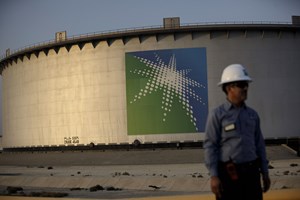Aramco pulls back on oil production expansion plan in surprise move ordered by Saudi government
(Bloomberg) – Saudi Aramco abandoned a plan to boost its oil production capacity, a huge reversal that will raise questions about the kingdom’s view on future demand.
The surprise move comes after the world’s biggest oil exporter had said in November that it was progressing “very well” with a multibillion-dollar project to boost capacity to 13 MMbpd by 2027 as demand in China and India continues to grow. Saudi Arabia currently has capacity for 12 MMbpd and is producing about 9 MMbpd, after it curbed production as part of OPEC+ efforts to revive the global oil market and prevent a surplus.
“There is likely to be much speculation on the potential implications on global oil demand over the medium and long term,” RBC Capital Markets analyst Biraj Borkhataria said in a note. “This also marks a change in tone from one of the world’s largest oil producers at the government level.”
The change in the investment plan ordered by the Saudi government comes at a time when Aramco has significantly increased dividend payments to the state, its primary owner. The kingdom is running a fiscal deficit as it spends tens of billions of dollars on efforts to diversify the economy into areas such as sports and tourism.
The decision will take out a significant portion of the supply buffer that traders were expecting for later this decade, a gap that may be hard to fill by others. Maintaining additional spare capacity is expensive, especially when the country is already producing well below its maximum rate and demand growth is likely to slow with the energy transition.
Aramco will update its capital spending plan when it announces annual results in March, according to a statement. RBC Capital Markets expects the company to lower its annual budget by about $5 billion from previous guidance.
While crude remains the backbone of the economy, Saudi Aramco is expanding in natural gas, chemicals and renewables. These businesses are likely to get a share of the money saved from the oil capacity expansion, a person familiar with the plans said.
The company is also expecting an additional 1 MMbpd of oil supply to be freed up for exports by 2030 as a result of the kingdom’s wider domestic plan to stop burning oil for power generation.
Additional Funds. The decision comes at a time when Aramco is paying much more in dividends to the government, even with its production being cut. The company — 98% state owned — raised its quarterly payout by more than $10 billion to $29.4 billion over the previous two quarters, as the government looks to fund its fiscal deficit.
Saudi Arabia will probably post a budget shortfall of about 4.3% of gross domestic product in 2024 and have more than $46 billion of funding requirements, according to Dubai-based bank Emirates NBD. That comes as the kingdom continues to spend tens of billions of dollars on tourism, sports and other projects championed by Crown Prince Mohammed bin Salman to diversify the economy.
Bloomberg Economics estimates that Saudi Arabia needs an oil price of $108 a bbl to balance its budget and meet domestic spending by the sovereign wealth fund. Crude in London is trading near $82 a bbl, holding largely steady as ample supplies from around the world counter a deepening crisis in the Middle East.
The Saudi announcement will add to the list of uncertainties confronting traders. There’s no sign to the end of Israel’s war on Hamas, Houthi militants are menacing global shipping in the Red Sea, and there’s an increasing risk of Iran being dragged into the wider turmoil in the region.
Saudi Arabia’s latest move will likely have long term implications for the oil market. Curbing its growth plans would leave the kingdom with a thinner production buffer in the future in the event of supply shocks, especially in a volatile Middle East.
But in the shorter term, the market doesn’t need Saudi production capacity at 13 MMbpd because there’s ample levels available after OPEC reduced output, according to Amrita Sen, director of research at consultant Energy Aspects Ltd.
“We have to ask ourselves the question – over what timeline” Aramco keeps the lower capacity, she said on Bloomberg Television.



